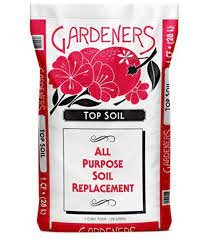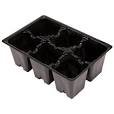Planting and Germination Instructions for Hubs
Please refer to the following instructions for planting and germinating California native nectar plants and milkweed seeds. Germination and purity rates for recently shipped seeds can be found at the bottom of this page.
Soil
Buy a good quality, well draining soil.
Some nurseries and garden centers are starting to carry a native plant blend which is ideal for California native plants but can be expensive for bulk growing. Typically, cactus mixes or seed starter are also suitable, although anything with added perlite can be used. Our Lemon Grove hub in San Diego County, ran by Chelsea G. has had great success rates using a well draining organic top soil (red bag shown) that currently sells for under $3 a bag.
Choosing Pots
4 inch nursery pots,
The 4 inch diameter pots do not take up much space while allowing seedlings plenty of room to develop a strong healthy root system before requiring transplanting. Make sure to select pots with plenty of drainage.
four or Six cell pony packs are a great option for clarkia, yarrow
Six cell pony packs are great for milkweed since ideally you will be giving away 5-6 milkweed plants per person.
If you choose to use a container that’s not originally intended for planting, such as red drinking cups or recycled containers, make sure to poke several holes in the bottom for drainage before planting.
A great way to get free pots is by sharing about your hub and putting out an ask in your community via “Buy Nothing” groups on Facebook, the Next Door app, or on social media to friends, family and neighbors.
Planting trays - some seeds do better in trays or flats . plant a healthy amount of seeds and see what germinates. Once the plant is a decent size you can transplant to 4 inch pots.
Preparing and Planting Pots
When filling pots with soil; push down firmly to settle soil but do not overly compact.
Dig a small hole in the center of the container about 1/8 to 1/4 inch deep and place anywhere from 2 to 4 seeds and lightly bury. Refer to germination and purity rates at the bottom of this page for how to tailor the number of seeds in each container for each type of native nectar plant. Milkweed seeds are larger and easier to see, we suggest planting 2-3 per container or cell.
Typically, native seeds are used to being on the surface when they fall and somewhat have access to light. A Reminder to not water too heavily; it can create enough movement to displace seeds and interfere with successful germination.
Place the container outdoors in full sun or in a south-facing window to sprout.
Watering
Nectar plant watering instructions
Water gently to avoid disturbing seed placement. Using a watering can is recommended.
Nectar plants should always stay moist when young.
Milkweed watering (as per the Payne Foundation milkweed planting instructions)
After the seed is sewn give the pot a good soak (gently) and make sure to wet the medium entirely. Place your container outdoors in full sun. Allow the surface to dry down before watering again but keep in mind that your seed is in the top inch of the soil that needs to stay moist so don't let it dry down too much. Water gently with a watering can so you do not push the seeds out. Your watering schedule will likely be every two to three days. Once the seeds have emerged, they will begin to drink up the water and watering will be more frequent, particularly after the plant starts putting in growth and begins to fill the pot with roots. Multiple individuals germinate in your pot you can thin or leave them clustered. Seedlings don't seem to mind growing in pairs. During heat waves when temperatures are severe such as in the Inland Empire prepare to water more frequently and on very hot days move them into shaded areas when the sun is strongest.
When to Plant
Sow Seeds at Appropriate Times
Monarch Fellowship’s goal is to ship seeds during months that they can be germinated and planted in the majority of California. Milkweed seeds are available for hubs to order from September through January, and California native nectar plant seeds are available beginning in January though August. Our goal is to ship nectar plant seeds so that they can be available for fall giveaways and planting ahead of the rainy season in addition to spring giveaways. The exceptions are the various Clarkia’s as they may not sprout until spring. Many hubs choose to just hold off planting Clarkia until spring.
WAIT TO PLANT MILKWEED UNTIL TEMPERATURES ARE CONSISTENTALY WARM- CONSISTANTLY OVER 80 DEGREES.
The most important thing about planting milkweed is to wait until the weather turns consistently warm. Milkweed seeds need heat to germinate. Milkweeds tend to germinate best when daytime temperatures are consistently above 80 degrees Fahrenheit. If you desire to start your seeds before outdoor temperatures allow, start milkweed indoors in a south-facing window or with a plastic cover to simulate a greenhouse effect.
Purity and Germination Rates and pot recommendations
Below are the germination and purity rates of each plant in the most recent CA native nectar plant seed giveaway (Fall 23/Spring24).
Choose the number of seeds to plant per container or cell according to these values.
For instance, fuchsia has a low purity rate so use a few MORE seeds per pot to account for the low purity.
Blue eyed grass and yarrow have both high purity and germination rates so LESS seeds can be used per container or cell.
Purity: The percent of seed of the lot that is the stated species. For example, a purity of 90% tells you that the other 10% of the bag content is inert matter (chaff).
Germination rate: Signifies the average number of seeds that will sprout given a specific amount of time.
pots
Clarkia unguiculata - Mountain Garland
difficulty level. easy
growing speed : fast
Deeper pony pak or 4 inch pots. (Doesn't like a lot of root disturbance)
Purity 99%
Germination rate 94%
Clarkia bottae - Punchbowl Godetia
difficulty level: easy
frowing speed: fast
plant in 4 or 6 cell pony packs or 4 inch pots
Purity 91%
Germination rate 88%
Stipa pulchra-Purple needlegrass
4 inch or deeper pony pack
difficluty: easy
speed: fairly fast
plant in trays or flats and transplant or in pony packs
purity 85%
Germination rate 65%
Achillea millefolium - White yarrow
difficulty easy
speed": medium
plant in 4 or 6 cell pony packs or 4 inch pots
Purity 99%
Germination rate 95%
Grindelia Camporum - Great Valley gumweed
difficulty easy
speed medium
plant in 4 inch pots
Purity 58%
Germination rate 52%
Encelia californica - California brittle bush
difficulty medium easy
speed medium
plant in 4 inch pots
Purity 48%
Germination rate 71%
Solidago Velutina Californica-California Goldenrod
difficulty: hard -
speed : slow
These seeds have a low success rate. Put all the seed in plant in a tray and transplant what comes up- use a generous amount of seeds since germ and purity are vary low
Purity 10 %
germination rate 10%
-Bicolor Lupine
difficulty : easy
speed fairly fast
4 inch pots (Doesn't like a lot of root disturbance)
High dormancy-soak for 24 hours or scratch surface lightly with sandpaper or on surface to break dormancy
99% purity
90% germination
Encelia Farinosa -Brittlebush
difficulty : rairly easy
speed medium
4 inch, or larger, pots
Purity 25%
gemination rate 50%
Eriophyllum confertiflorum- Golden yarrow
difficulty easy to medium
plant in pony packs or 4 inch pots
purity 30%
germination 50%
Helanthus bolanderi- bolanders sunflower
4 inch or larger pot
purity 80%
Germination 50%
Linum lewisii - Blue Flax
Deeper pony pack or 4 inch pots. (Doesn't like a lot of root disturbance)
difficulty : fairly easy
speed : takes a while to germinate
purity 90%
germination 50%
california buckweat Eriogonum fasciculatum
difficulty medium
speed: slow- can take a while to germinate and maybe 5-6 months before you can hand out
plant in trays and transplant or in 4 inch pots.
purity: unknown
germination rate unknown
california poppy: Eschscholzia californica
difficulty easy
speed: slow- fast
Deeper pony pack or 4 inch pots. (Doesn't like a lof of root disturbance)
purity: high
germination rate high
Bladderpod - Peritoma arborita
4 inch, or larger, pots
difficulty - can be easy if low dormancy









